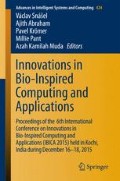Abstract
Unified Modeling Language models are the de facto industry standard for object-oriented modeling of the static and dynamic aspects of software systems. To ensure software quality, it is essential to maintain consistency between the models. Inconsistencies among the diagrams of a model may result in serious faults which are hard to detect and may lead to project failure. Complex systems require large number of diagrams and hence detection of inconsistencies among the diagrams has a significant role during the design phase of software development. In this paper we describe a method for detection of inconsistencies among the class and activity diagrams using particle swarm optimization technique. Particle Swarm Optimization (PSO) is a soft computing technique that provides solutions to optimization problems by maximizing certain objectives in a complex search space. The PSO algorithm is applied to detect inconsistency and to optimize the consistency value of the attributes to ensure consistency. The application of PSO algorithm provides consistent, optimized diagrams that result in the generation of more accurate code.
Access this chapter
Tax calculation will be finalised at checkout
Purchases are for personal use only
References
Floreano., D, Mattiussi, C.: Bio-inspired Artificial Intelligence: Theories, Methods, and Technologies. MIT Press, Cambridge (2008)
Kennedy., J, Eberhart, R.: Particle swarm optimization. In: Proceedings of IEEE International Conference on Neural Networks, vol. IV, pp. 1942–1948 (1995)
Liu, Wn., Easterbrook, S., Mylopoulos, J.: Rule-based detection of inconsistency in uml models. In: Workshop on Consistency Problems in UML-Based Software Development, vol. 5 (2002)
Blanc, X., Mougenot, A., Mounier, I., Mens, T.: Incremental detection of model inconsistencies based on model operations. In: CAiSE, vol. 9, pp. 32–46 (2009)
Particle Swarm Optimization.: http://www.swarmintelligence.org
Van Der Straeten., R., Mens, T., Simmonds, J., Jonckers, V.: Using description logic to maintain consistency between UML models. In: “UML” 2003-The Unified Modeling Language. Modeling Languages and Applications, pp. 326–340. Springer Berlin Heidelberg (2003)
O’Keeffe, M., O, Cinneide, M.: Towards automated design improvement through combinatorial optimization. In: Proceedings of Workshop on Directions in Software Engineering Environments (2004)
Blanc., X., Mounier, I., Mougenot, A., Mens, T.: Detecting model inconsistency through operation-based model construction. In: ACM/IEEE 30th International Conference on Software Engineering, 2008. ICSE’08, pp. 511–520. IEEE (2008)
Dubauskaite, R., Vasilecas, O.: Method on specifying consistency rules among different aspect models, expressed in UML. Elektronika ir Elektrotechnika 19(3), 77–81 (2013)
Egyed., A.: Instant consistency checking for the UML. In: Proceedings of the 28th International Conference on Software Engineering, pp. 381–390. ACM (2006)
Van Der Straeten, R., Simmonds, J., Mens, T.: Detecting inconsistencies between UML models using description logic. Description Logics 81 (2003)
Saini, D.K., Sharma, Y.: Soft computing particle swarm optimization based approach for class responsibility assignment problem. Soft Comput. 40(12) (2012)
Ducatelle., F, Di Caro, G.A., Gambardella, L.M.: Principles and applications of swarm intelligence for adaptive routing in telecommunications networks. Swarm Intell. 4(3) 173–198 (2010)
Shamshiri, M., Gan, C.K., Mariana, Y., Ruddin, M., Ghani, A: Using particle swarm optimization algorithm in the distribution system planning. Aust. J. Basic Appl Sci 7(3), 85–92 (2013)
Revathi, C., Mythily, M.: A Uml/Marte detection of starvation and deadlocks at the design level in concurrent system. Int.J. Comput. Technol. Appl. 4(2), 279–285 (2013)
Nytun, J.P., Jensen, C.S.: Modeling and testing legacy data consistency requirements. In: “UML” 2003-The Unified Modeling Language. Modeling Languages and Applications, pp. 341–355. Springer, Berlin Heidelberg (2003)
Engels, G., Küster, J.M., Heckel, R., Groenewegen, L.: A methodology for specifying and analyzing consistency of object-oriented behavioral models. In: ACM SIGSOFT Software Engineering Notes, vol. 26, no. 5, pp. 186–195. ACM (2001)
Kennedy, J., Kennedy, J.F., Eberhart, R.C., Shi, Y.: Swarm Intelligence. Morgan Kaufmann (2001)
Peram, T., Veeramachaneni, K., Mohan, C.K.: Fitness-distance-ratio based particle swarm optimization. In: Swarm Intelligence Symposium, SIS’03, Proceedings of the 2003 IEEE, pp. 174–181. IEEE (2003)
Bai., Qinghai.: Analysis of particle swarm optimization algorithm. Computer and information science 3, no. 1, p. 180 (2010)
Hu, X., Eberhart, R.C.: Adaptive particle swarm optimization: detection and response to dynamic systems. In: WCCI, pp. 1666–1670. IEEE (2002)
De Souza, L.S., de Miranda, P.B.C., Prudencio, R.B.C., de Barros, F.: A multi-objective particle swarm optimization for test case selection based on functional requirements coverage and execution effort. In: 23rd IEEE International Conference on Tools with Artificial Intelligence (ICTAI), pp. 245–252. IEEE (2011)
Huzar, Z., Kuzniarz, L., Reggio, G., Sourrouille, J.L.: Consistency problems in UML-based software development. In: UML Modeling Languages and Applications, pp. 1–12. Springer Berlin, Heidelberg (2005)
Author information
Authors and Affiliations
Corresponding author
Editor information
Editors and Affiliations
Rights and permissions
Copyright information
© 2016 Springer International Publishing Switzerland
About this paper
Cite this paper
George, R., Samuel, P. (2016). Particle Swarm Optimization Method Based Consistency Checking in UML Class and Activity Diagrams. In: Snášel, V., Abraham, A., Krömer, P., Pant, M., Muda, A. (eds) Innovations in Bio-Inspired Computing and Applications. Advances in Intelligent Systems and Computing, vol 424. Springer, Cham. https://doi.org/10.1007/978-3-319-28031-8_10
Download citation
DOI: https://doi.org/10.1007/978-3-319-28031-8_10
Published:
Publisher Name: Springer, Cham
Print ISBN: 978-3-319-28030-1
Online ISBN: 978-3-319-28031-8
eBook Packages: EngineeringEngineering (R0)

